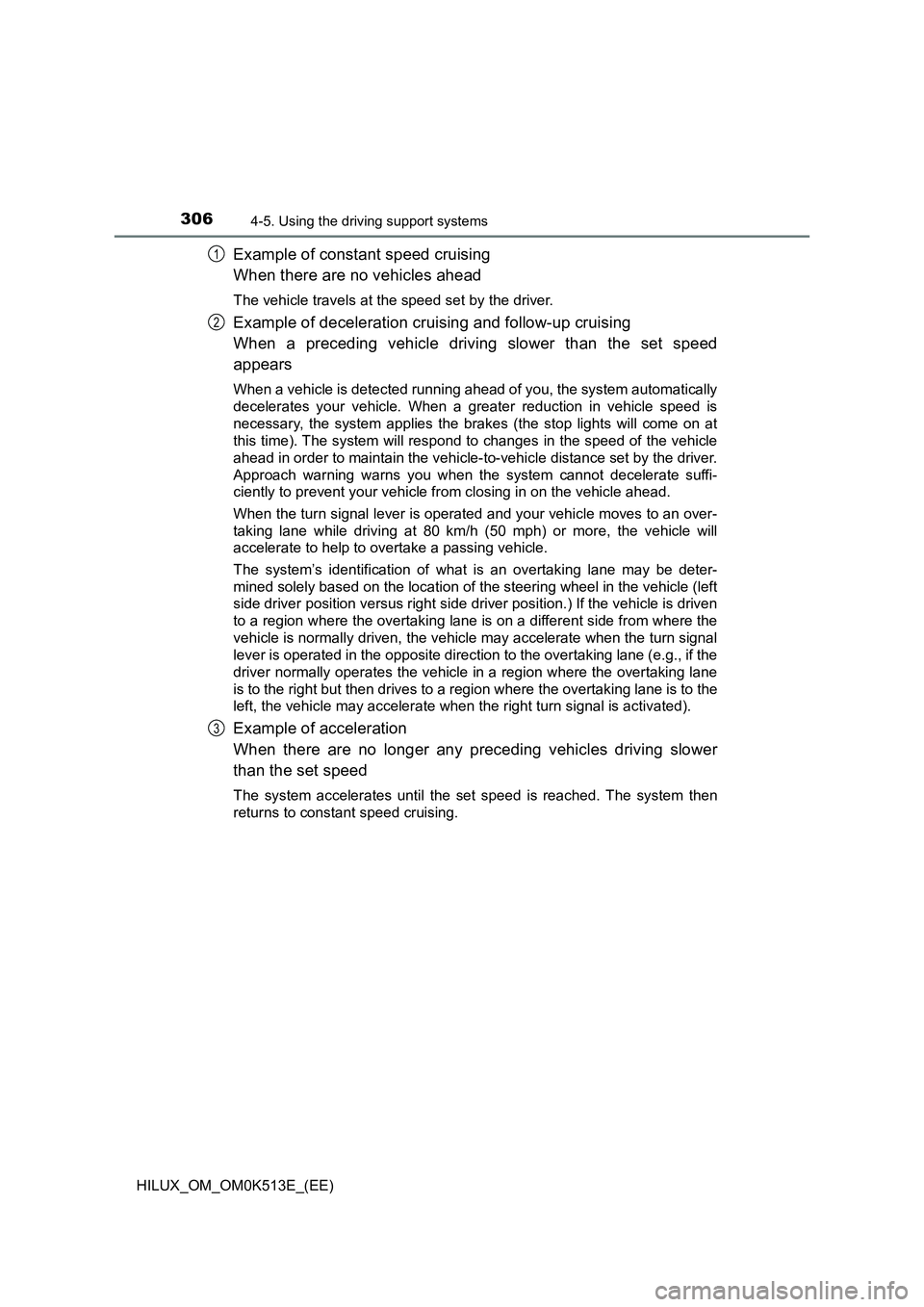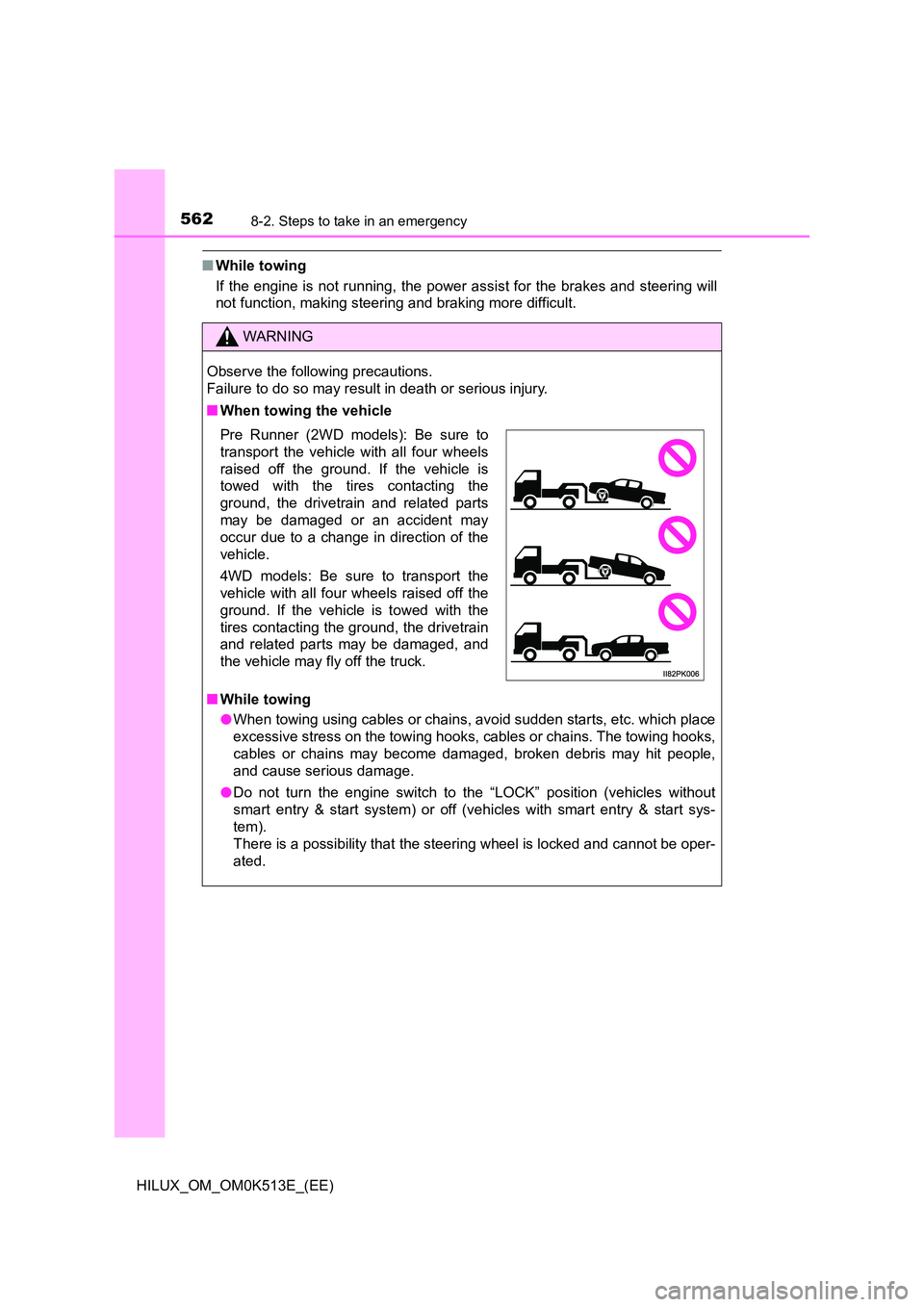2022 TOYOTA HILUX change wheel
[x] Cancel search: change wheelPage 308 of 798

3064-5. Using the driving support systems
HILUX_OM_OM0K513E_(EE)
Example of constant speed cruising
When there are no vehicles ahead
The vehicle travels at the speed set by the driver.
Example of deceleration cruising and follow-up cruising
When a preceding vehicle driving slower than the set speed
appears
When a vehicle is detected running ahead of you, the system automatically
decelerates your vehicle. When a greater reduction in vehicle speed is
necessary, the system applies the brakes (the stop lights will come on at
this time). The system will respond to changes in the speed of the vehicle
ahead in order to maintain the vehicle-to-vehicle distance set by the driver.
Approach warning warns you when the system cannot decelerate suffi-
ciently to prevent your vehicle from closing in on the vehicle ahead.
When the turn signal lever is operated and your vehicle moves to an over-
taking lane while driving at 80 km/h (50 mph) or more, the vehicle will
accelerate to help to overtake a passing vehicle.
The system’s identification of what is an overtaking lane may be deter-
mined solely based on the location of the steering wheel in the vehicle (left
side driver position versus right side driver position.) If the vehicle is driven
to a region where the overtaking lane is on a different side from where the
vehicle is normally driven, the vehicle may accelerate when the turn signal
lever is operated in the opposite direction to the overtaking lane (e.g., if the
driver normally operates the vehicle in a region where the overtaking lane
is to the right but then drives to a region where the overtaking lane is to the
left, the vehicle may accelerate when the right turn signal is activated).
Example of acceleration
When there are no longer any preceding vehicles driving slower
than the set speed
The system accelerates until the set speed is reached. The system then
returns to constant speed cruising.
1
2
3
Page 349 of 798

3474-5. Using the driving support systems
4
Driving
HILUX_OM_OM0K513E_(EE)
When the engine is stopped by the Stop & Start system when the
vehicle is on an incline, when the brake pedal is released, brake force
is temporarily maintained to prevent the vehicle from rolling back-
wards before the engine is restarted and drive force is generated.
When drive force is generated, the maintained brake force is automat-
ically canceled.
�O This function operates on flat surfaces as well as steep inclines.
�O Sound may be generated from the brake system, but this does not
indicate a malfunction.
�O Brake pedal response may change and vibration may occur, but
this does not indicate a malfunction.
�Q Points for use
�O If the engine switch is pressed when the engine is stopped by the Stop &
Start system, the engine will not be able to be restarted by the automatic
engine start function. In this case, restart the engine using the normal
engine starting procedure. ( P. 220, 223)
�O When the engine is being restarted by the Stop & Start system, the power
outlets may be temporarily unusable, but this does not indicate a malfunc-
tion.
�O Installation and removal of electrical components and wireless devices may
affect the Stop & Start system. Contact any authorized Toyota retailer or
Toyota authorized repairer, or any reliable repairer for details.
�O When stopping the vehicle for a longer period of time, turn the engine switch
to the “LOCK” position*1 or off*2 to stop the engine completely.
�O When the engine is restarted by the Stop & Start system, the steering wheel
may temporarily feel heavy.
�O 4WD models only: While driving in L4 mode, it is recommended that the
Stop & Start system be canceled because the system may not operate prop-
erly.
*1: Vehicles without smart entry & start system
*2: Vehicles with smart entry & start system
Hill-start assist control (vehicles with automatic transmission)
Page 351 of 798

3494-5. Using the driving support systems
4
Driving
HILUX_OM_OM0K513E_(EE)
�O When the engine is stopped by the Stop & Start system, the engine will be
restarted automatically if any of the following conditions are met:
(To enable the engine to be stopped by the Stop & Start system again, drive
the vehicle.)
• The air conditioning system is turned on. (vehicles without manual air
conditioning system)
• is turned on. (vehicles without manual air conditioning system)
• The shift lever is shifted from D or P. (vehicles with automatic transmis-
sion)
• The shift lever is shifted from P. (When the engine is stopped by the Stop
& Start system when the shift lever is in P.) (vehicles with automatic trans-
mission)
• The driver’s seat belt is unfastened.
• The driver’s door is opened.
• The driving mode is changed from normal or Eco drive mode to another
mode. (if equipped)
• The rear differential is locked. (if equipped)
• The Stop & Start cancel switch is pressed.
• The steering wheel is operated.
• The accelerator pedal is depressed. (vehicles with automatic transmis-
sion)
• The vehicle starts to roll on an incline.
�O When the engine is stopped by the Stop & Start system, the engine may
restart automatically in the following situations:
(To enable the engine to be stopped by the Stop & Start system again, drive
the vehicle.)
• When the brake pedal is pumped or strongly depressed.
• When the air conditioning system is being used.
• When a switch of the air conditioning system is operated ( , etc.).
• If the battery charge becomes low.
�Q When the hood is opened
�O If the hood is opened while the engine is stopped by the Stop & Start sys-
tem, the engine will stall and will not be able to be restarted by the automatic
engine start function. In this case, restart the engine using the normal
engine starting procedure. ( P. 220, 223)
�O If the hood is closed after the engine is started with the hood open, the Stop
& Start system will not operate. Close the hood, turn the engine switch to the
“LOCK” position*1 or off*2, wait 30 seconds or more, and then start the
engine.
*1: Vehicles without smart entry & start system
*2: Vehicles with smart entry & start system
Page 381 of 798

379
5
5-1. Basic Operations
Audio system
HILUX_OM_OM0K513E_(EE)
Using the steering wheel audio switches
Vo lu m e
• Press: Increases/decreases vol-
ume
• Press and hold: Continuously
increases/decreases volume
Radio mode:
• Press: Select a radio station
saved in preset stations
• Press and hold until you hear a
beep: Seek up/down
CD, MP3/WMA/AAC disc, iPod, USB or Bluetooth® audio mode:
• Press: Select a track/file
• Press and hold until you hear a beep: Select a folder or album
“MODE” switch
• Press: Turn the power on, select an audio source
• Press and hold until you hear a beep:
Radio or AUX mode: Mute
CD, MP3/WMA/AAC disc, iPod, USB or Bluetooth® audio mode:
Pause the current operation.
To cancel the mute or pause, press and hold the switch again.
�Q Changing the audio source
Press the “MODE” switch when the audi o system is turned on. The audio
source changes as follows each time the button is pressed. If a mode cannot
be used, it will be skipped.
AM FMCD modeiPod or USB memoryBluetooth® audioAUX
Some audio features can be controlled using the switches on
the steering wheel.
Operation may differ depending on the type of audio system or
navigation system. For details, refer to the manual provided with
the audio system or navigation system.
Vehicles without audio system: P. 4 7 0
1
2
3
Page 564 of 798

5628-2. Steps to take in an emergency
HILUX_OM_OM0K513E_(EE)
�QWhile towing
If the engine is not running, the power assist for the brakes and steering will
not function, making steering and braking more difficult.
WARNING
Observe the following precautions.
Failure to do so may result in death or serious injury.
�Q When towing the vehicle
�Q While towing
�O When towing using cables or chains, avoid sudden starts, etc. which place
excessive stress on the towing hooks, cables or chains. The towing hooks,
cables or chains may become damaged, broken debris may hit people,
and cause serious damage.
�O Do not turn the engine switch to the “LOCK” position (vehicles without
smart entry & start system) or off (vehicles with smart entry & start sys-
tem).
There is a possibility that the steering wheel is locked and cannot be oper-
ated.
Pre Runner (2WD models): Be sure to
transport the vehicle with all four wheels
raised off the ground. If the vehicle is
towed with the tires contacting the
ground, the drivetrain and related parts
may be damaged or an accident may
occur due to a change in direction of the
vehicle.
4WD models: Be sure to transport the
vehicle with all four wheels raised off the
ground. If the vehicle is towed with the
tires contacting the ground, the drivetrain
and related parts may be damaged, and
the vehicle may fly off the truck.
Page 580 of 798

5788-2. Steps to take in an emergency
HILUX_OM_OM0K513E_(EE)
�Q If “Oil maintenance required soon” is shown
The engine oil is scheduled to be changed.
Check the engine oil, and change if necessary. After changing the engine oil,
the oil change system should be reset. ( P. 491)
For Russia, Armenia, Ukraine, Byelarus, Moldova, Bosnia Herzegovina, Mon-
tenegro, Serbia and Macedonia: You have forgotten to reset the oil change
system. Change the engine oil in accordance with the maintenance schedule.
�Q If “Oil maintenance required” is shown
The engine oil is scheduled to be changed.
Check and change the engine oil, and oil filter by any authorized Toyota
retailer or Toyota authorized repairer, or any reliable repairer. After changing
the engine oil, the oil change system should be reset. ( P. 491)
For Russia, Armenia, Ukraine, Byelarus, Moldova, Bosnia Herzegovina, Mon-
tenegro, Serbia and Macedonia: You have forgotten to reset the oil change
system. Change the engine oil in accordance with the maintenance schedule.
�Q If “Differential oil temp high Shift to 2WD mode Cooling time required” or
“Differential oil temp high Co oling time required” is shown
The differential oil temperature is too high.
Turn the front-wheel drive control switch to H2, and reduce the vehicle speed
or stop the vehicle in a safe place. ( P. 331)
�Q If “Engine oil level low Add or replace” is shown
The engine oil level is low. (This warning message may be displayed if the
vehicle is stopped on a slope. Move the vehicle to a level surface and check
to see if the message goes off.)
Check the level of the engine oil and add or replace oil if necessary.
( P. 479)
�Q If “Power turned off to save battery” is shown
Power was turned off due to the automatic power off function.
Next time when starting the engine, increase the engine speed slightly and
maintain that level for approximately 5 minutes to recharge the battery.
�Q If “DPF full Manual regeneration required See owner’s manual” is shown
The deposit collected in the filter needs to be regenerated. ( P. 371)
�Q If “DPF regeneration in progress” is shown
Regeneration is being automatically carried out by the DPF system.
( P. 370)